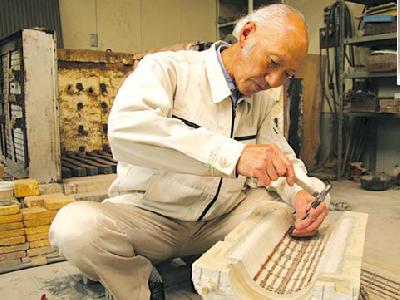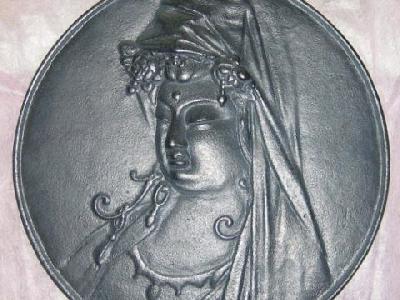|
Chukin is a casting technique where molten metal is poured into a mold to make a vessel or utensil.
The chukin technique dates back a long way to the Yayoi period and features a variety of casting methods: 'sogata' ('so' technique), 'rogata' (lost wax technique), 'sunagata' (with sand) and 'yakigata' (by firing).
Depending on the shape and form of the object to be cast, the correct method should be used. The casting processes invcolve great experience and advanced skill.
Living National Treasure Osawa Komin was born in 1941 in Takaoka-shi, Toyama Prefecture, an area famous for copperware. Osawa is designated as a holder of the important intangible cultural property of metal casting. Known as the master of 'yakigata' casting, Osawa researched and came up with an original technique called 'casting basis technique', in which patterns are directly impressed on the surface of the vessel.
Despite the responsibility involved in inheriting such a traditional technique, Osawa ingeniously applies the technique to meet the expectations and standards of the modern world. He always keeps in mind his original intentions, while constantly moving forward and expressing fresh, natural sensibilities and sensations. Osawa is constantly challenging himself in the world of metal casting.
The chukin technique dates back a long way to the Yayoi period and features a variety of casting methods: 'sogata' ('so' technique), 'rogata' (lost wax technique), 'sunagata' (with sand) and 'yakigata' (by firing).
Depending on the shape and form of the object to be cast, the correct method should be used. The casting processes invcolve great experience and advanced skill.
Living National Treasure Osawa Komin was born in 1941 in Takaoka-shi, Toyama Prefecture, an area famous for copperware. Osawa is designated as a holder of the important intangible cultural property of metal casting. Known as the master of 'yakigata' casting, Osawa researched and came up with an original technique called 'casting basis technique', in which patterns are directly impressed on the surface of the vessel.
Despite the responsibility involved in inheriting such a traditional technique, Osawa ingeniously applies the technique to meet the expectations and standards of the modern world. He always keeps in mind his original intentions, while constantly moving forward and expressing fresh, natural sensibilities and sensations. Osawa is constantly challenging himself in the world of metal casting.
| [+ADDRESS] | 
|














